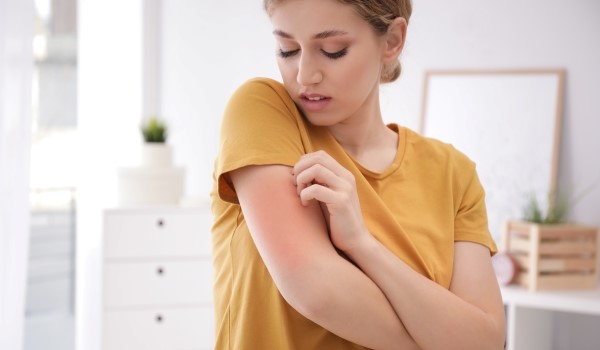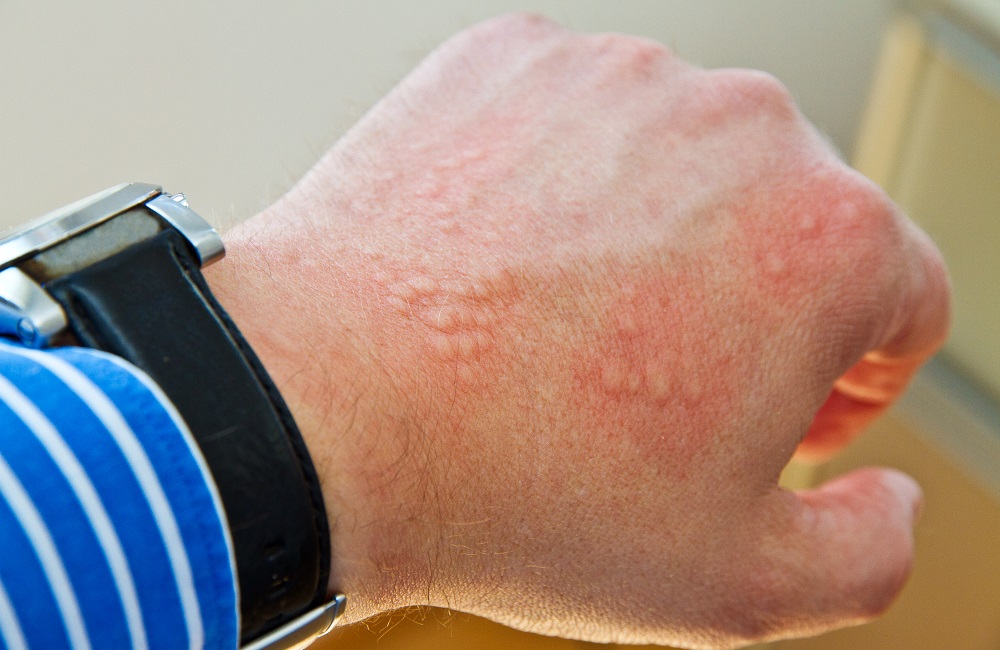What is actually a
Symptomatic dermographism?
Symptomatic dermographism (also known as urticaria factitia or “made urticaria”) is a skin disease characterized by a hypersensitive reaction of the skin to mechanical stimuli. With this disease, those affected develop red, itchy and raised skin rashes, known as wheals or welts, after slight pressure or friction on the skin.
Symptomatic dermographism occurs in people of all age groups, although women are more frequently affected than men. The exact cause of the itchy wheals is often unknown.
About the symptoms
More information
Important facts about symptomatic dermographism
Symptoms and consequences of symptomatic dermographism:
- Wheals or welts caused by slight pressure or friction on the skin. They can occur anywhere on the body and vary in shape, size and extent.
- Severe itching sensations, accompanied by a burning or stinging sensation
- Spontaneous regression of the skin changes or long-term persistence
- Sleep disorders, irritability, impairment of quality of life due to severe itching sensations
- Skin irritation, redness and infections due to increased scratching
How can symptomatic dermographism be classified?
Symptomatic dermographism is a special form of urticarial dermographism (physical hives) that is triggered by external physical stimuli such as pressure, light, cold, heat or water. The disease is individual and can progress differently in different people. Some remain asymptomatic, while others develop severe symptoms. Chafing clothing, for example, can trigger the typical symptoms. These can also occur chronically and last for months or years.
White dermographism is a separate form of urticarial dermographism in which the skin reacts to pressure or friction. In contrast to symptomatic, this disease causes white, swollen lines or swellings on the irritated or scratched areas instead of the typical red wheals.
In contrast to other forms of hives caused by allergic reactions, there is no specific allergic or immunological reaction in all forms of urticarial dermographism.
Causes of symptomatic dermographism
The exact causes of symptomatic dermographism are not yet fully understood. According to the current state of research, the following triggers are associated with the development of the skin disease:
Hypersensitive skin reaction
Hypersensitive skin reaction
Changes in the skin barrier and increased responsiveness of mast cells
Histamine release
Histamine release
Dilation of the blood vessels, typical skin reaction (wheals and redness) as a result
Genetic predisposition
Genetic predisposition
Certain genetic variant
Immunological factors
Immunological factors
Impaired regulation of the immune system
Individual triggers
Individual triggers
e.g. tight clothing, scratchy materials, heat or cold
How is symptomatic dermographism diagnosed?
As symptomatic dermographism is a visible and reproducible reaction of the skin to mechanical stimuli, the diagnosis is comparatively uncomplicated in most cases and does not usually require extensive examinations.
The following aspects are decisive for the dermatologist’s or allergist’s diagnosis:
Individual stimulus threshold - provocation test using a blunt wooden spatula
Latency, duration and itching of the striped wheals
Different manifestations of the symptoms

What to do in case of symptomatic dermographism?
Avoiding triggers
Identify potential triggers that can trigger your symptoms, such as tight clothing, scratchy materials or certain environmental factors. Stress can also at least intensify the symptoms of symptomatic dermographism. Look for coping strategies that help you to reduce stress, such as regular physical activity, relaxation techniques like meditation or breathing exercises, and getting enough sleep.
Suitable skin care
Care for your skin regularly with gentle and moisturizing products. Use mild detergents and avoid harsh soaps or aggressive skin care products. Well cared for skin can help to reduce irritation and strengthen the skin barrier.
Alleviation of complaints
The use of antihistamines can be helpful in reducing itching, redness and swelling. However, it is important to take antihistamines according to a doctor's instructions in order to minimize possible side effects and achieve the best possible effect. Cooling compresses or cold water can also relieve itching quickly in mild cases.
Sources
Please note that all content provided regarding individual medical conditions, treatments, procedures, etc. is general information and may vary depending on the physician:in and individual case and initial situation.
For more detailed information, please always consult your doctor.
Website of the UNEV - urticaria network e. V.: What is urticaria factitia?
www.urtikaria.netMarcus Maurer: Treating urticaria is becoming easier and easier
www.medical-tribune.deWebsite of the online encyclopedia of dermatology, venereology, allergology and environmental medicine: Urticaria factitia.
www.enzyklopaedie-dermatologie.deFleischer M, Grabbe J (2004) Physical urticaria. Dermatologist 55: 344-349